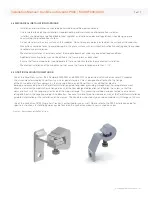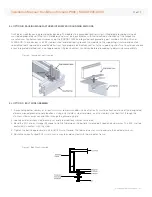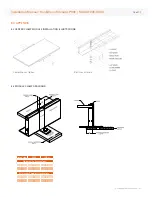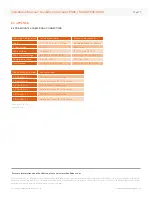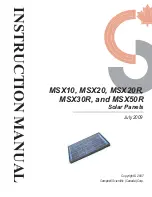
3.2 STORAGE, UNPACKING, AND HANDLING
•
Packaged modules must be stored in a dry and ventilated area.
•
Packaged modules must not be exposed to rain, snow, hail or other environmental conditions that may compromise the
packaging material and the modules.
•
Packaged modules must be on appropriate provided pallets and must not be stacked more than two pallet high for
storage.
•
Once the modules are opened, store modules in a dry and ventilated room.
•
Modules should never be stored in a wet environment.
•
Upon unpacking, do not carry a module by its wires or junction box. Only carry a module by its frame with two or more
people.
•
Precaution should be taken to avoid damage to the glass surface with or without anti-reflective coating due to improper
handling during storage or unpacking.
•
Keep all electrical contacts clean and dry.
•
All modules are manufactured with a sealed junction box and pre-attached cables and locking connectors. These
components should not be modified or tampered with in any way.
•
Do not allow unauthorized persons near the installation site or storage area of modules.
•
Do not place modules on top of one another.
•
Do not place any load on the module or twist the module frame.
•
Do not stand, step, walk, or jump on the module.
•
Do not drop or place objects on the modules such as tools.
•
Do not handle modules with bare hands and avoid scratches, handling marks or any damage, especially to the front
glass of the module, backsheet, or electrical components.
•
Do not mark the modules with sharp instruments.
•
Do not leave a module unsupported or unsecured.
•
Do not modify module frames in any way.
3.3 SAFETY
The following safety guidelines and best practices should be followed:
•
All installations must be performed in compliance with all applicable regional and local electrical codes or other national
or international electrical standards.
•
Use insulated tools during installation, troubleshooting and maintenance of photovoltaic modules.
•
Wear suitable protection to prevent direct contact with module’s electrical output and mechanical sharp edges.
•
Cover the front of the modules with an opaque material to stop production of electricity when installing or working with
a module or wiring.
•
Modules connected in a series should not be disconnected under illumination. Disconnecting modules under
illumination may cause electrical arcing which may result in burns, fires or other problems.
•
Follow industry best practices when commissioning, troubleshooting, disconnecting, or connecting a PV system.
•
Troubleshooting should include planning, checking, disconnecting, cause seeking, replacement, and record keeping.
•
Do not install or handle the modules or their components when they are wet or during periods of high wind.
•
Do not attempt to disassemble, repair, or open any part of the module including junction box or sub-components.
•
Do not artificially concentrate sunlight on a module.
•
Do not install or handle any broken modules. If a module is broken, or the back sheet is torn, contact with the surface or
frame can cause an electrical shock.
•
Do not wear rings, jewelry, watches, or other metallic items while working with photovoltaic modules.
3 of 17
Installation Manual: SunEdison Silvantis P300 | M330/F330/D330
© Copyright 2014 SunEdison, Inc.








